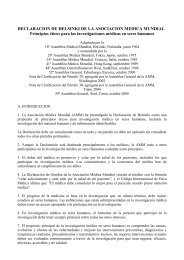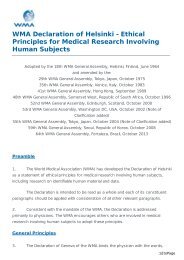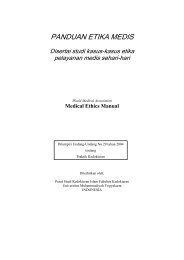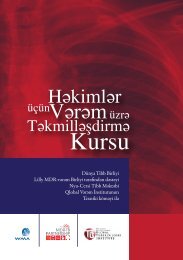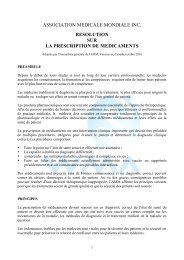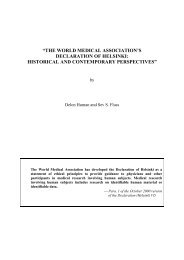WMJ 05 2011 - World Medical Association
WMJ 05 2011 - World Medical Association
WMJ 05 2011 - World Medical Association
You also want an ePaper? Increase the reach of your titles
YUMPU automatically turns print PDFs into web optimized ePapers that Google loves.
NORWAY<br />
Social Disparities<br />
time a social gradient in the distribution<br />
of health and disease is well documented;<br />
there are dramatic differences in health between<br />
the socially advantaged and disadvantaged<br />
between and within any country<br />
[1]. Should physicians take this fact into<br />
account in their clinical practice and act affirmatively<br />
to correct socioeconomic biases<br />
Would this be possible whilst preserving<br />
the ethos of avoiding unfair discrimination<br />
in their professional work<br />
WMA ethical<br />
recommendations: A tension<br />
Avoidance of unfair discrimination is stated<br />
in the Physician’s Oath in the WMA Declaration<br />
of Geneva as: “I will not permit<br />
considerations of religion, nationality, race,<br />
party politics or social standing to intervene<br />
between my duty and my patient”. Adopted<br />
just three months before the UN Declaration<br />
of Human Rights, the Oath acknowledges<br />
the equal worth of every human being;<br />
every individual is morally entitled to equal<br />
concern. The Oath does not, however, establish<br />
any broader concern for social justice.<br />
At the same time, the WMA recognizes<br />
the challenges that social disparities in<br />
health poses to the health care system. In<br />
2009, the association adopted a Statement<br />
on Inequalities in Health (quoted in Box<br />
1). Although the major causes of health inequalities<br />
lie outside health care, the WMA<br />
insisted that within the health care system<br />
physicians play a major role in health promotion<br />
and disease prevention, and states<br />
their responsibility “(t)o identify, treat and<br />
reduce existing health inequality”. The<br />
recommended list of physicians’ responsibilities<br />
includes identification of social and<br />
financial factors that impact on inequality,<br />
advocating for equal access to health care,<br />
and promotion of research and education<br />
on social inequality.<br />
The Physician’s Oath and the Statement on<br />
Inequalities in Health can be seen to pull in<br />
opposite directions. On the one hand, the<br />
physician should not let social and economic<br />
factors influence clinical judgments. On<br />
the other hand, the physician should contribute<br />
to a reduction in the unacceptable<br />
social inequality in health – an inequality<br />
that clearly correlates with social and economic<br />
factors.<br />
Empirical support for clarifying<br />
the ethical regulation of<br />
professional practice<br />
Whether the different regulations are inconsistent<br />
depends on their practical interpretations<br />
and implications. Some empirical<br />
evidence indicates a need for clarification of<br />
how ‘unfair discrimination’ actually should<br />
be interpreted in practice. A recent survey<br />
of a representative sample of Norwegian<br />
physicians found that 55% agreed that physicians<br />
should contribute to reducing social<br />
health inequalities in the population by<br />
supplying extra help to patients of low socioeconomic<br />
status [2]. On the other hand,<br />
most of the responding physicians reported<br />
‘never’ or ‘rarely’ to take social factors into<br />
account in their clinical practice.<br />
The need for clarification is also supported<br />
by other empirical findings. Several studies<br />
find that physicians, as everyone else, are<br />
subject to unacknowledged influence from<br />
social and cultural factors. Such influence<br />
can e.g. be observed when physician and<br />
patient are similar in socio-cultural aspects,<br />
which makes it easier for the physician to<br />
judge the patient’s situation and needs [3].<br />
Other studies show that patients with higher<br />
socioeconomic status have better access<br />
to specialized care [4].<br />
To explicitly ignore information about the<br />
patient’s socioeconomic status in clinical<br />
decision making as expressed in the Oath,<br />
may lead to an unjustified unawareness<br />
of the interplay between socioeconomic<br />
factors and access to healthcare. Consequently,<br />
physicians may end up enhancing<br />
health disparities rather than reducing<br />
them because of a lack of attention to the<br />
ways socioeconomic factors work in favor<br />
of the socioeconomically advantaged on<br />
one side and against the disadvantaged on<br />
the other.<br />
A reasonable way to take nonmedical<br />
factors into account<br />
Hence, the open question is how the relevant<br />
non-medical factors should be taken<br />
into account at the point of individual care.<br />
The need to underscore the importance of<br />
avoiding irrelevant and/or unfair factors in<br />
healthcare decisions is clear. The risk of an<br />
unacceptable influence on healthcare decision<br />
making from strong economic and/<br />
or social interests is always present; as is<br />
the risk that prejudice or political belief<br />
leads to discrimination – unconsciously or<br />
not. Therefore, ordinary medical fairness is<br />
commonly interpreted as to allow no other<br />
concerns than medical need to influence the<br />
decision [5].<br />
That medical need should be the only criterion<br />
for priority to care is, however, not<br />
as straightforward as it may look at first<br />
sight. The reason for this is the close interplay<br />
between socioeconomic status and<br />
medical need. Any physician will know that<br />
patients differ in their ability to utilize the<br />
same medical regimen; some patients need<br />
more information than others, some need<br />
more follow up in order to comply, some<br />
need financial support, etc. The differences<br />
in ability to benefit from treatment are not<br />
only due to medical factors, but are also<br />
closely connected to factors in the social<br />
and cultural settings of the individual. A<br />
reasonable interpretation of what it means<br />
to treat patients as moral equals by giving<br />
them equal concern is that every patient<br />
should have the same opportunity to benefit<br />
from treatment. Consequently, a medical<br />
need for healthcare must be understood according<br />
to the patient’s individual biologi-<br />
197



